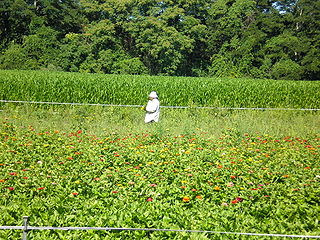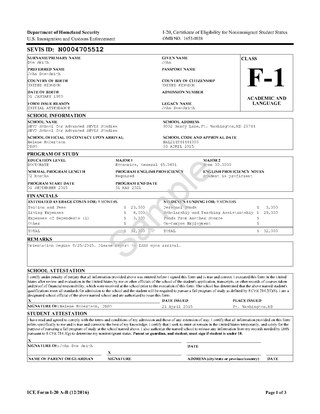The Student and Exchange Visitor Program (SEVP) is a program within U.S. Immigration and Customs Enforcement, which is under the U.S. Department of Homeland Security, to manage foreign students and exchange visitors in the United States through the Student and Exchange Visitor Information System (SEVIS). The SEVP encompasses the F status, J status, and M status. The exchange visitor part of the program is managed by the U.S. Department of State, although the SEVIS system is maintained by ICE.

Foreign workers or guest workers are people who work in a country other than one of which they are a citizen. Some foreign workers use a guest worker program in a country with more preferred job prospects than in their home country. Guest workers are often either sent or invited to work outside their home country or have acquired a job before leaving their home country, whereas migrant workers often leave their home country without a specific job in prospect.
The H-1B is a visa in the United States under the Immigration and Nationality Act, section 101(a)(15)(H), that allows U.S. employers to employ foreign workers in specialty occupations. A specialty occupation requires the application of specialized knowledge and a bachelor's degree or the equivalent of work experience. The duration of stay is three years, extendable to six years, after which the visa holder can reapply. Laws limit the number of H-1B visas that are issued each year. There exist congressionally mandated caps limiting the number of H-1B visas that can be issued each fiscal year, which is 65,000 visas, and an additional 20,000 set aside for those graduating with master’s degrees or higher from a U.S. college or university. An employer must sponsor individuals for the visa. USCIS estimates there are 583,420 foreign nationals on H-1B visas as of September 30, 2019. The number of issued H-1B visas have quadrupled since the first year these visas were issued in 1991. There were 206,002 initial and continuing H-1B visas issued in 2022.
An au pair is a person from a foreign country working for, and living as part of, a host family. Typically, au pairs take on a share of the family's responsibility for child care as well as some housework, and receive a monetary allowance or stipend for personal use. Au pair arrangements are often subject to government restrictions which specify an age range usually from mid teens to late twenties, and may explicitly limit the arrangement to females. The au pair program is considered a form of cultural exchange that gives the family and the au pairs a chance to experience and learn new cultures.

A student exchange program is a program in which students from a secondary school or higher education study abroad at one of their institution's partner institutions. A student exchange program may involve international travel, but does not necessarily require the student to study outside their home country.

Employee benefits and benefits in kind, also called fringe benefits, perquisites, or perks, include various types of non-wage compensation provided to employees in addition to their normal wages or salaries. Instances where an employee exchanges (cash) wages for some other form of benefit is generally referred to as a "salary packaging" or "salary exchange" arrangement. In most countries, most kinds of employee benefits are taxable to at least some degree. Examples of these benefits include: housing furnished or not, with or without free utilities; group insurance ; disability income protection; retirement benefits; daycare; tuition reimbursement; sick leave; vacation ; social security; profit sharing; employer student loan contributions; conveyancing; long service leave; domestic help (servants); and other specialized benefits.
Some students from the United States pursue educational opportunities outside the United States. This can include primary, secondary and post-secondary students.

The Disney International Programs is an international internship program operated by the Disney Programs division of The Walt Disney Company at the Walt Disney World Resort in Lake Buena Vista, Florida, in the United States. These programs recruit participants and college students from outside the United States and its territories for year-long cultural exchanges with paid positions and summer-long paid internships, working at the Walt Disney World Resort. The programs are designed to attract international workers and students and share many similarities with the US-based Disney College Program and its philosophy of Living, Learning and Earning.
The Congress-Bundestag Youth Exchange is a youth student exchange program founded in 1983. The program, which is jointly sponsored by the United States Congress and the German Bundestag, funds exchange programs for German and American students through grants to private exchange organizations in both countries. The funding in the United States is administered by the Bureau of Educational and Cultural Affairs of the United States Department of State.

Visitors to the United States must obtain a visa from one of the U.S. diplomatic missions unless they are citizens of one of the visa-exempt or Visa Waiver Program countries.

The Form I-20 is a United States Department of Homeland Security, specifically ICE and the Student and Exchange Visitor Program (SEVP), document issued by SEVP-certified schools that provides supporting information on a student's F or M status. Since the introduction of the Student and Exchange Visitor Information System (SEVIS) run by SEVP, the form also includes the student tracking number and school code. The Form I-20 is only for F-1, F-2, M-1, and M-2 statuses. J-1 and J-2 status holders have an equivalent Form DS-2019 which is issued by a United States Department of State-designated J exchange visitor program.
In the United States, the F visas are a type of non-immigrant student visa that allows foreigners to pursue education in the United States. F-1 students must maintain a full course of study. F-1 visas are only issued in U.S. embassies and consulates, although extensions of stay and changes of status may be possible within the United States. Prospective F-1 students must apply at the schools and receive a form I-20 in order to apply for an F-1 visa. F-1 students must show that they are able to support themselves during their stay in the U.S., as their opportunities for legal employment are quite limited. F-2 visas are given to dependents of an F-1 student. F-2 visa-holders are prohibited from any form of compensated employment. However, minor children may attend public schools. Finally, the F-3 visa is issued to Canadians and Mexicans who commute across the border to attend American schools.
The Council on International Educational Exchange (CIEE) is a non-profit organization promoting international education and exchange. It was founded in 1947 and is based in the United States. The organization is headquartered in Portland, Maine.

A J-1 visa is a non-immigrant visa issued by the United States to research scholars, professors and exchange visitors participating in programs that promote cultural exchange, especially to obtain medical or business training within the U.S. All applicants must meet eligibility criteria, English language requirements, and be sponsored either by a university, private sector or government program. J-1 visa holders must usually return home for two years following visa expiration so they impart cultural knowledge learned in the United States. In 2022, the State Department issued 284,486 J-1 visas, with a visa approval rate of 88.8%. Between 2001 and 2021, there were 6,178,355 J-1 visas issued by the State Department. In 2023, there were 4,209 J-1 visa sponsors. Certain J-1 categories saw increased percentage increase in visas between 2021 and 2022. For example, The J-1 Visa for Summer Work/Travel increased 134% from 39,647 to 92,619. J-1 Teachers increased 467% from 719 to 4,076. Interns increased 212% from 5,402 to 16,833.
The United States Social Security Administration's Ticket to Work and Self-Sufficiency Program is the centerpiece of the Ticket to Work and Work Incentives Improvement Act of 1999.
The M-1 visa is a type of student visa in the U.S. reserved for international students attending vocational schools and technical schools.
Work and Travel USA is a United States Government program that allows foreign university students to travel and work within the United States for several months. Run by the U.S. Department of State, the program has approximately 100,000 participants between ages 18 and 30 each year. Each student is sponsored by an American employer.

Cultural Vistas is a nonprofit 501(c)(3) organization that facilitates internships and professional exchange programs and services for visitors coming to the U.S., and American students and professionals seeking experiential learning opportunities abroad. The organization is headquartered in New York City, with regional offices located in Berlin and Washington, D.C.
The Congressional International Exchange and Study Caucus is a caucus of the United States Congress that aims to raise awareness of the importance and benefits of international exchange and study abroad programs, which enable international citizens to have meaningful exchange experiences in the United States, and Americans to have such beneficial experiences in other countries. It is co-chaired in the 114th Congress by Representatives Steve Pearce of New Mexico and Jim Himes of Connecticut.
In the United States, the most common visa used for short-term trips is the B visa. This is a combination of the B-1 visa and the B-2 visa. People on B visas are generally not allowed to engage in productive work or study activities. However, in some cases, B visas can be issued that allow people to engage in some types of productive work and learning activity, in lieu of another visa. The three visa categories, for which a B visa could be issued instead, are the H-1B visa, H-3 visa, and J-1 visa. The U.S. Department of State recommends that consular officers clearly annotate such B visas to make the scope of the visa clear to the applicant and the U.S. Customs and Border Protection officer at the port of entry.







